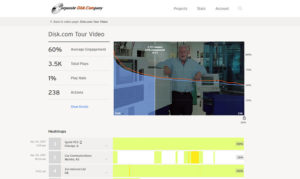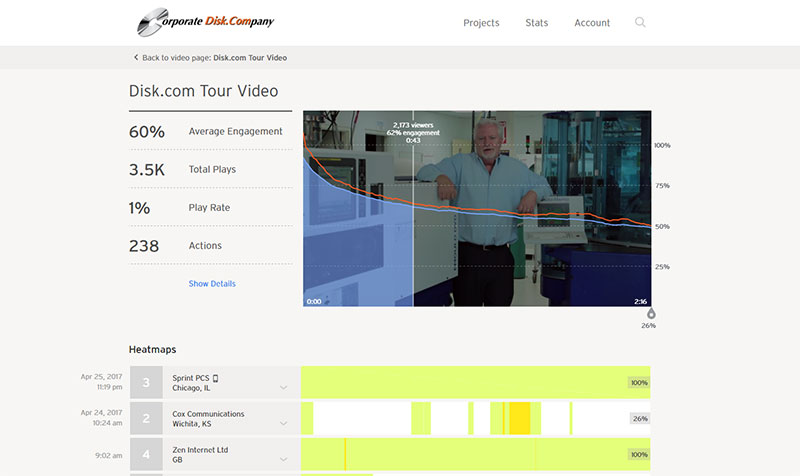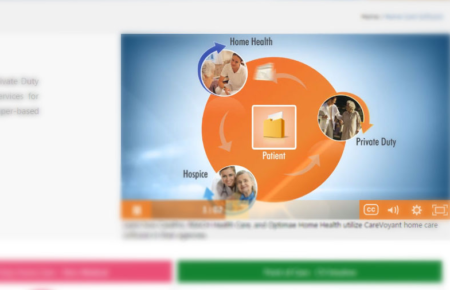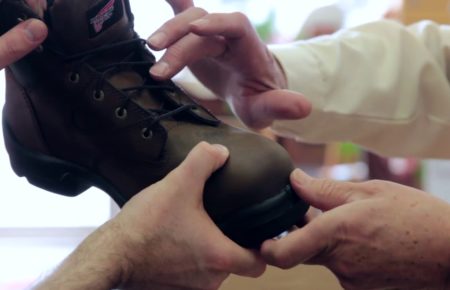Are you marketing with video all wrong? (Part 3)
Welcome to our final installment of “Are You Marketing with Video All Wrong?” In this article, we’ll walk you through the some of the insights having data about your content can provide. Not into data? Barely got through statistics in college? That’s OK – we won’t bust out any math on you!
If you haven’t already the digested our previous installments, then please do! To recap, in Part 1, we discuss the need to make video strategically, and in Part 2, we discuss the benefits of video hosting as a means to measure your video success.
 We sat down with our friend, Jason Hyde, the VP of Marketing at Disk.com. These are some of his thoughts on how he uses data to sharpen his video marketing strategy and to help increase customer conversions.
We sat down with our friend, Jason Hyde, the VP of Marketing at Disk.com. These are some of his thoughts on how he uses data to sharpen his video marketing strategy and to help increase customer conversions.
As a marketer, what kind of data is most important to you?
Initially, I thought views was important. But now, I realize how the really important numbers are related to viewer engagement. For instance, if you have 5 videos – one is played more but has lower engagement. And, another has fewer plays but a significantly better engagement, then I know this topic is interesting to viewers. Maybe we should make more videos like this. Or, maybe we should add a call to action at the beginning or end of this video to help drive interested customers to fill out a form. I love knowing that I have access to viewing trends based on real individuals and NOT just a generic “someone somewhere in this state watched your video.” I can follow up with an actual, qualified, person!
How has your plan to make video evolved?
Our initial plan was primarily driven as a need to offer up a fun explanation about what we do and how many different things we do. We wanted to make videos that help explain all of our main business segments. Not everyone realizes all the things we can do, and we wanted to change that.
Now, we want to dive a little deeper into some specifics and hone in on our core messaging and branding. Also, we want to focus on videos for lead generation and further awareness of some of our printing and packaging solutions. We also want to start making video specifically for social media.
-
Speed1x
-
Quality540p

Thanks for reporting a problem. We’ll attach technical data about this session to help us figure out the issue. Which of these best describes the problem?
Any other details or context?
Are there additional benefits of metrics and viewer engagement tracking?
Having video on our site from our video hosting account, we get to know so much more about our visitors’ viewing habits. I also like being able to duplicate the video, place it in a new project, and post it on Facebook, for example, and being able to compare that with what the engagement is like with that same video on our website.
Our most popular video is the first one that we created with you guys. It’s got a laid-back style, and it’s front and center on our site. We still get positive comments on that one.
-
Speed1x
-
Quality540p

Thanks for reporting a problem. We’ll attach technical data about this session to help us figure out the issue. Which of these best describes the problem?
Any other details or context?
We like that we also have been building a library of videos that touch on our main business segments and, more importantly, address common misconceptions. We have a couple videos focused on storage media and we get a chance to educate customers on our concept of information navigation, and how we apply that across CDs, DVDs and USB Media.
One of the best reasons to use video is that we can demonstrate so much more, so much more quickly than pages of text or text with images. We want our videos to improve our customers’ decision-making process.
We want to make sure our customers are well-educated about the choices they make to create and even market their own products.
-
Speed1x
-
Quality540p

Thanks for reporting a problem. We’ll attach technical data about this session to help us figure out the issue. Which of these best describes the problem?
Any other details or context?
How do video analytics help you measure the success of your video plan?
Our plan now is shaped by the data we’ve gathered on the video we’ve already produced. In looking at the trends portion of the analytics, I notice there are two videos with similar play rates but with very different engagement rates and different messages. The one, on the magic of packaging, is really fun and even has some cool effects. The other, on printed trade show materials, addresses a specific need our customers must have.
This surprised us. But, it shows specific examples of trade show type material – in a fun way – I think that reflects our customers’ desire to fix a problem they have.
Ultimately, having the data and a strategy lets us act like scientists – with video!
We create a theory, create some content, and then test the performance of that content against that theory. We can then make improvements that make our videos even better – more educational, more on topic, more specific!
Going forward, we know that we’ll continue to make videos that attempt to address the needs our customers already have in so much as we have a service to address it.
How else has your video data helped informed other business decisions?
In looking at the deeper audience metrics, we can track regions of the US and even internationally. If we’re getting a spike in visitors from the UK or Europe – places we don’t normally focus on in our advertising – then we know we should be investing in those geographic regions. They seem to have a need we can solve.
What is your next video goal?
We want to hone in further on specific videos and make more use of CTAs [calls-to-action]. We want to create content with more focused information, and with a more deliberate customer conversion path.
 Thanks for your thoughts, Jason! Keep up the hard work at Disk.com!
Thanks for your thoughts, Jason! Keep up the hard work at Disk.com!
As you can see from Jason’s example, the goals you’ve set dictate what kinds of data you should focus on when measuring the success of your video efforts.
Working with a video marketing company is helpful for when you start to get overwhelmed when focusing on data. They’ll help you uncover insights that you can turn into action.
































